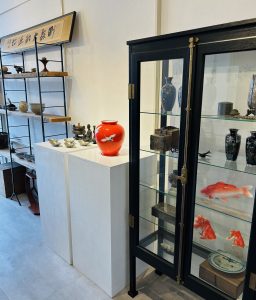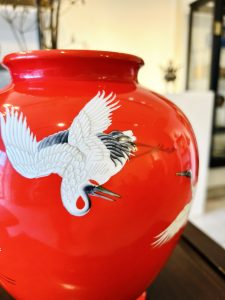明治時代の人々の気概を感じます(愛知県名古屋市千種区姫池通 骨董買取 古美術風光舎)
2023.11.12
みなさまこんにちは、スタッフHでございます。
昨日のブログでノリタケ(株式会社ノリタケカンパニーリミテド)について綴るつもりが、金魚の話に没頭してしまったので本題に戻りたいと思います。

皆さまよくご存知だとは思いますが、ノリタケは明治時代にメイドインジャパンの西洋様式の陶磁器を生み出した民間初の日米貿易会社です。西洋の様式に日本人の感性を取り込み、独特のスタイルでアメリカを中心に人気を博しました。明治から昭和初期頃(戦前)、国内で販売されたものやアメリカなど海外へ輸出した陶磁器は「オールドノリタケ」と呼ばれ現在もコレクターが多いとのこと。
私、ノリタケは名古屋で生まれた会社だと思い込んでいたのですが、実は東京銀座で創業した森村組という貿易会社が元となっています。名古屋にノリタケが誕生するまでの経緯を調べてみました。
まず森村組が創業される背景に当時の金の海外流出が関係していると言われています。歴史の授業のようになりますが、1854年に横浜にペリーが乗った黒船が来航し、日本は開国することとなります。当時の日本は金のレートが海外と異なり、国内では金と銀の比率がおよそ1:5であったのに対し、海外では比率が1:15となっていました。つまり日本では銀貨5枚で金貨が1枚貰えることとなり、開国にともない金が海外へ大量に流出していきました。
そこで森村組の創業者、森村市左衛門が福沢諭吉による「外国に流出した金を取り戻すには輸出貿易によって外貨を獲得する必要がある」という言葉に共感し、海外貿易を行うことを決意します。
1876年東京の銀座に日本初の日米貿易会社、森村組を創業。当初は陶磁器を自分たちで作っていたわけではなく、日本の骨董品や工芸品を輸出していました。その2年後、弟の森村豊(とよ)がニューヨークのマンハッタンに「モリムラブラザーズ」を創業し、日本の雑貨を販売します。
今でさえマンハッタンに店を出すなど、気後れしてしまいそうですが、当時の若者たちの熱意は強く、店に寝泊まりしながら、最低限の食事をし質素倹約を貫いたのだとか。こういった当時の人の努力により日本の対米輸出は20年で10倍に成長し貴重な外貨を稼いだとのこと。
またアメリカの生活スタイルに合ったティーセットなどを試行錯誤を重ね、自社で製作するようになっていきます。1882年に初めて愛知県の瀬戸から陶磁器の素地を仕入れます。しかし絵付けは東京、京都にある森村組専属の絵付け工場で行われていました。素地を瀬戸で作らせ、名古屋で荷受けしたものを東京、京都の工場へ送り、絵付けした後に横浜や神戸から輸出するという工程を踏んでいましたが、扱う商品の量が増えてくると、費用がかさむ上に迅速性も欠き、輸送中での破損もあり改善が迫られていました。
名古屋は素地の主力生産地である瀬戸に近く、立地条件に恵まれており、各地に散らばった専属絵付け工場を名古屋に集約するべく各工場に働きかけました。しかし東京や京都の画工たちは容易にその土地を離れようとせず、説得を続けた結果ようやく了解を得られました。こうして1898年頃、名古屋市東区橦木町を中心に画工が移り住み一大工場が誕生します。
そして1904年に現在の名古屋市西区則武新町に近代的な製陶法を採り入れた大規模な製陶工場が建設されました。それが日本陶器合名会社(現ノリタケカンパニーリミテド)となります。
ノリタケの歴史は長く、ここまでかなり省略しました。壮大すぎてブログで書ききれるものではありませんでしたね。
現在も赤レンガ棟や6本の煙突などが残る西区のノリタケの森。。紅葉の季節にお出かけされてはいかがでしょうか。
それでは、またお会いしましょう。

Hello everyone, this is Staff H.
I was going to write about Noritake (Noritake Co., Ltd.) in yesterday’s blog, but I got lost in talking about goldfish, so I would like to return to the main topic.
As you are probably well aware, Noritake was the first privately owned Japanese-U.S. trading company that produced Western-style ceramics and porcelain made in Japan during the Meiji era (1868-1912). The company incorporated Japanese sensibilities into Western styles and gained popularity in the United States and other countries for its unique style. The ceramics and porcelain sold in Japan from the Meiji period to the early Showa period (before World War II) and exported to the United States and other foreign countries are called “Old Noritake” and many collectors still collect them today.
I had assumed that Noritake was born in Nagoya, but in fact, it originated from a trading company called Morimura-gumi, which was founded in Ginza, Tokyo. I looked into the background to the birth of Noritake in Nagoya.
It is said that the background to the founding of Morimura-gumi was related to the outflow of gold overseas at the time. This may sound like a history lesson, but in 1854, Perry’s black ships arrived in Yokohama and Japan opened its borders to the outside world. At that time, the gold exchange rate in Japan was different from that overseas, with the ratio of gold to silver being approximately 1:5 in Japan, while overseas the ratio was 1:15. In other words, for every five silver coins in Japan, one could receive one gold coin, and with the opening of the country, a large amount of gold flowed overseas.
Ichizaemon Morimura, the founder of Morimura Gumi, agreed with Yukichi Fukuzawa’s words that “in order to recover the gold that has flowed abroad, it is necessary to earn foreign currency through export trade,” and decided to engage in overseas trade.
In 1876, he founded Japan’s first Japan-U.S. trading company, Morimura-gumi, in Ginza, Tokyo. At first, they did not make ceramics themselves, but exported Japanese antiques and crafts. Two years later, his younger brother Toyo Morimura founded Morimura Brothers in Manhattan, New York, to sell Japanese goods.
Even today, one might be intimidated by the idea of opening a store in Manhattan, but the enthusiasm of the young people of the time was so strong that they slept in the store, ate a minimal diet, and were frugal. Thanks to their efforts, Japan’s exports to the U.S. grew tenfold in 20 years, earning valuable foreign currency.
In 1882, the company purchased its first ceramic base from Seto in Aichi Prefecture, but the painting process was outsourced to Tokyo and Kyoto. However, painting was done at Morimura Gumi’s exclusive painting factories in Tokyo and Kyoto. However, as the volume of products handled increased, the process became more expensive, less prompt, and prone to breakage during transportation.
However, as the volume of products handled increased, it became more and more expensive, and the process was not quick enough, and the products were damaged in transit, so improvements were needed. However, the Tokyo and Kyoto artisans were reluctant to leave the area, and after much persuasion, Nagoya finally agreed to the plan. Around 1898, a large factory was established in the area centered on the town of Yuriki-cho, Higashi-ku, Nagoya City, where the artists moved to.
In 1904, a large-scale pottery factory was built in Noritake-shinmachi, Nishi-ku, Nagoya City, using modern pottery manufacturing methods. It became Nippon Toki Gomei Kaisha (now Noritake Co., Ltd.).
The history of Noritake is a long one, and I have omitted a lot of details up to this point. It is too grand to be written in a blog.
Today, the red brick building and six chimneys still remain in the Noritake Garden in Nishi Ward. Why not visit during the season of autumn leaves?
Well, I will see you soon.
*******************
ご実家の整理やお片付けなどをされている方のご相談などが多くございます。
お片付けなどくれぐれもご無理のないようになさってくださいませ。
風光舎では古美術品や骨董品の他にも絵画や宝石、趣味のお品など様々なジャンルのものを買受しております。
お片付けをされていて、こういうものでもいいのかしらと迷われているものでも、どうぞお気軽にご相談下さいませ。
また風光舎は、出張買取も強化しております。ご近所はもちろん、愛知県内、岐阜県、三重県その他の県へも出張いたします。
まずは、お電話お待ちしております。
***************************************
愛知県名古屋市千種区姫池通
骨董 買取【古美術 風光舎 名古屋店】
TEL052(734)8444
10:00-17:00 OPEN
#出張買取#骨董#古美術#骨董品#絵画#版画#茶道具#刀剣#彫刻

